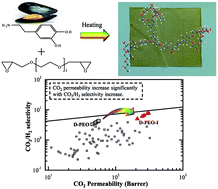A bio-inspired CO2-philic network membrane for enhanced sustainable gas separation†
Abstract
For the first time, the exciting reaction between the bio-inspired dopamine and the epoxy functional poly(ethylene oxide) (PEO) at elevated temperatures was found and utilized for fabricating dopamine/poly(ethylene oxide) (PEO) network membranes for sustainable gas separation. The gas transport properties of the synthesized novel membrane were investigated aiming at energy (H2) purification and CO2 capture. The membrane was confirmed to be CO2 selective and exhibited relatively high selectivity especially for CO2/N2 separation. Importantly, the flexible incorporation of low-molecular-weight poly(ethylene glycol) dimethyl ether (PEGDME) into the swollen network membrane greatly improved the gas transport performance and the CO2 permeability was increased by 550%. Furthermore, the temperature and upstream pressure dependence of our developed membranes have been examined in detail. Surprisingly, the plasticization phenomena in the membranes at higher upstream pressure can be harnessed to enhance the gas transport performance by increasing both the CO2 permeability and the CO2/other tested gas selectivity mainly due to the network structure and CO2-philic character. This report will expedite the rapid discovery of new materials derived from bio-inspired dopamine for possibly solving energy and environmental issues.


 Please wait while we load your content...
Please wait while we load your content...